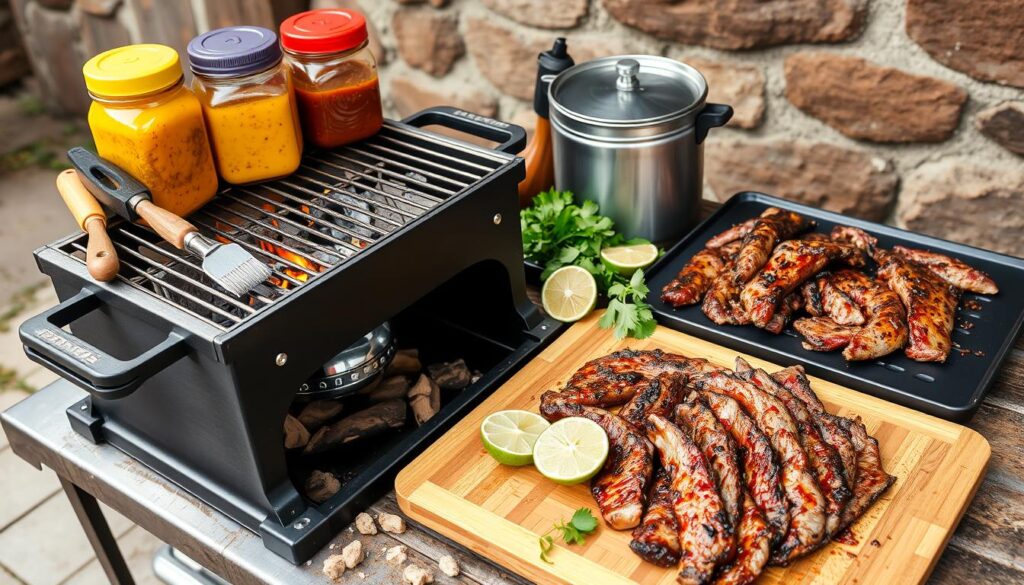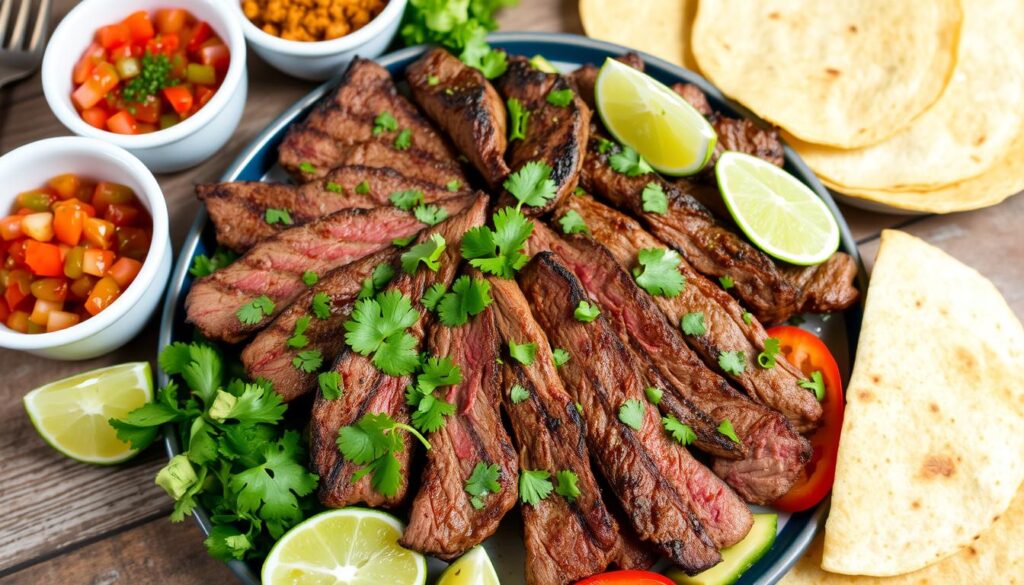Get ready to indulge in a mouth-watering Carne Asada recipe, a true Mexican classic. It’s perfect for any occasion. This flavorful dish is made with marinated flank steak or skirt steak, grilled to perfection, and bursting with flavor. With its rich history and cultural significance, Carne Asada is a must-try for anyone looking to experience the authentic taste of Mexico.
To make this delicious Carne Asada recipe, you will need the following equipment:
1. Grill
2. Cutting board
3. Knife
4. Meat mallet
5. Cast iron skillet
And follow these steps:
1. Prepare the marinade
2. Marinate the steak
3. Preheat the grill
4. Grill the steak
5. Let it rest
6. Slice and serve
Key Takeaways
- Carne Asada is a flavorful Mexican classic made with marinated flank steak or skirt steak
- The ideal grill temperature for Carne Asada is 450-500°F
- Cooking time for skirt steak is 4 minutes per side, while flank steak takes 7-8 minutes per side
- Desired internal temperature for medium-rare steak is 135°F
- Leftover Carne Asada can be stored in an airtight container for up to 3 days or frozen for up to 3 months
- Reheating time for Carne Asada is 1 to 3 minutes in a hot skillet or microwave
The Rich History of Carne Asada in Mexican Cuisine
Carne Asada is a key part of Mexican cuisine, with roots going back to the 1500s. It became popular in northern Mexico with ranching. This dish is loved at fiestas and special events, showing its cultural importance.
Grilling meat in Mexico has a long history, starting with indigenous peoples. Cultural significance shines in how Carne Asada is made and shared. Recipes and cooking methods have been passed down for generations.
Origins of the Dish
Carne Asada started in northern Mexico, where ranching was common. It uses thin cuts of beef, like skirt or flank steak. These cuts soak up marinades well and cook fast on grills.
Cultural Significance
Carne Asada is more than food; it’s a symbol of Mexican cuisine and cultural significance. It’s a must-have at family gatherings and parties. Making and sharing it brings people together.
Regional Variations
Carne Asada is loved across Mexico, but each region has its own twist. Some popular variations include:
- Carne Asada tacos, which are popular in California and Arizona
- Carne Asada with pineapple juice, a common variation in some Mexican recipes
- Carne Asada with adobo, a staple in Central American cuisine

In conclusion, Carne Asada’s rich history and cultural significance make it a cornerstone of Mexican cuisine. It’s a way to unite people, and its variations showcase the unique tastes of different areas.
| Region | Variation | Ingredients |
|---|---|---|
| Northern Mexico | Traditional Carne Asada | Skirt or flank steak, lime juice, garlic, spices |
| California and Arizona | Carne Asada Tacos | Skirt or flank steak, tortillas, salsa, avocado |
| Central America | Carne Asada with Adobo | Skirt or flank steak, adobo sauce, onions, bell peppers |
Essential Equipment for Perfect Carne Asada
To make the perfect Carne Asada, you need the right Carne Asada equipment. This includes grilling tools and kitchen essentials. These tools will help you prepare and cook the dish perfectly.
A grill or grill pan is key for Carne Asada. It allows for high-heat searing. This gives the dish its unique flavor and texture. You’ll also need tongs, a spatula, and a meat thermometer.
For preparing the dish, you’ll need some kitchen essentials. These include:
- A sharp knife for trimming and slicing the meat
- A cutting board for preparing ingredients
- A large bowl for marinating the meat
- A whisk for mixing the marinade

With the right Carne Asada equipment and kitchen essentials, you’re set to make a delicious Carne Asada. Choose high-quality grilling tools and kitchen essentials for the best results.
Selecting the Best Cut of Meat
Choosing the right meat for Carne Asada is key. Flank steak and skirt steak are top picks. Skirt steak, especially the outside cut, is the tenderest and tastiest. It’s a bit hard to find, though.
Inside skirt is a good substitute if outside skirt is not available. It’s a bit tougher but still tasty. Flank steak is also used, but it needs good marinating to be tender.
For skirt steak, aim for a thickness of at least 1/2 inch. Cook it for 3-4 minutes on each side at 600 degrees Fahrenheit for medium rare.
Comparison of Cuts
- Skirt steak: tender and flavorful, with two types (outside and inside)
- Flank steak: tougher if not properly marinated, but still a popular cut
Choosing between flank steak and skirt steak depends on what you prefer and what’s available. With the right marinade and cooking, both can make a delicious Carne Asada.
Nutritional Information
| Nutrient | Amount |
|---|---|
| Calories | 307 |
| Protein | 33g |
| Fat | 12g |
By picking the right meat and cooking it right, you can make a tasty and healthy Carne Asada.
Traditional Carne Asada Recipe Marinade
To make a tasty flavorful marinade for Carne Asada, you’ll need a few ingredients:
- 1/3 cup olive oil
- 1/4 cup soy sauce
- 2 tablespoons balsamic vinegar
- 1/4 cup orange juice
- 1/3 cup lime juice
- 4 garlic cloves
- 1/2 cup chopped cilantro
- 1 1/2 teaspoons chipotle powder
- 1 teaspoon onion powder
- 1 teaspoon ground cumin
- 1 teaspoon Mexican dry oregano
A traditional Carne Asada marinade is simple to make. It needs just a few ingredients. This marinade is key to making your Carne Asada dish memorable. It’s a classic recipe that works well in many Latin American regions.
Put all the ingredients in a bowl and mix them well. Place your 2 lbs of flap steak or skirt steak in a large ziplock bag. Pour the marinade over the steak. Seal the bag and refrigerate for at least 1 hour or up to 24 hours.
Preparing Your Meat for Marination
Preparing the meat for marination is key in Carne Asada. You need to trim and tenderize it right. This ensures the marinade coats the meat evenly and cooks well.
Experts say trimming the meat is crucial. It removes excess fat and connective tissue. This lets the marinade soak into the meat better. Tenderizing, like pounding or using a meat mallet, also helps. It makes the meat tender.
Here are some tips for preparing your meat for marination:
- Trim any excess fat or connective tissue from the meat
- Pound the meat to an even thickness to ensure consistent cooking
- Use a meat mallet or tenderizer to break down the fibers and make the meat more tender
Follow these tips and use the right tenderizing methods. Your Carne Asada will be delicious and tender. Always marinate the meat for at least 4 hours. But 24 hours is best for deep flavor penetration.
| Marinade Time | Results |
|---|---|
| 4 hours | Good flavor penetration |
| 24 hours | Optimal flavor penetration and tenderization |
Grilling Techniques for Authentic Flavor
To get that real Carne Asada taste, you need the right grilling methods. Grill the steak hot to sear the outside and keep the inside juicy. Experts say to preheat the grill to about 500 degrees Fahrenheit before adding the steak.
The grill type matters too. Cowboy Charcoal, for example, offers a consistent grilling experience. The marinade is also key, tenderizing the meat and adding flavor. A good marinade mixes lime or orange juice with chili powder and cumin.
- Grill the steak hot for 7-10 minutes on each side for a great sear.
- Use a meat thermometer to check the steak’s internal temperature. Aim for medium-rare, around 130-135°F.
- Let the steak rest for a few minutes after grilling. This helps the juices spread and keeps the meat tender.
By using these grilling techniques and a good marinade, you’ll get authentic Carne Asada flavor. Always choose fresh, quality ingredients. Don’t be afraid to try new spices and seasonings to find your favorite mix.
Temperature and Timing Guidelines
To get the perfect Carne Asada, knowing the right temperature and timing is key. The meat’s temperature is crucial for its doneness. Experts say the best grill temperature is medium-high, around 400 degrees Fahrenheit.
The meat’s thickness also matters. For a 1 ½ pound flank steak, cooking time varies. It can be 8 to 12 minutes per side, depending on how done you like it. Always use a meat thermometer to check the internal temperature. For medium-rare, aim for 145 degrees Fahrenheit.
Cooking Times by Thickness
Cooking times change based on the meat’s thickness. Here are some guidelines:
- 1-1 ½ pounds: 8-12 minutes per side
- 1 ½-2 pounds: 10-15 minutes per side
Keep in mind, these are just estimates. The actual time may vary based on the meat and your desired doneness.
Determining Doneness
Checking if Carne Asada is done can be tricky. But there are ways to make sure. You can use the touch test. Press the meat gently with your finger. If it’s soft and squishy, it’s rare. If it’s firm and springy, it’s medium-rare. If it’s hard and doesn’t spring back, it’s well-done.
Another way is to use a meat thermometer. It gives a precise internal temperature reading.
By following these guidelines, you’ll get a Carne Asada that’s perfectly cooked. It will have a deliciously charred outside and a juicy inside. Always prioritize food safety and use a meat thermometer to ensure the meat is cooked to a safe temperature.
Resting and Slicing Your Carne Asada
After cooking your Carne Asada to perfection, it’s key to let it rest before slicing. Carne Asada resting helps the juices spread out, making the meat tender and flavorful. This step is vital for the best taste and texture.
To slice your Carne Asada, use a sharp knife and cut it thinly against the grain. Slicing techniques greatly affect the outcome, so be patient and slice carefully. You can use a meat slicer or a sharp chef’s knife for even, thin slices.
Here are some tips for resting and slicing your Carne Asada:
- Let the meat rest for a few minutes before slicing to allow the juices to redistribute.
- Use a sharp knife to slice the meat thinly against the grain.
- Slice the meat in a consistent thickness to ensure even cooking and texture.
By following these tips and using the right slicing techniques, you’ll enjoy tender meat that’s full of flavor and texture. Always let your Carne Asada rest before slicing. This makes a huge difference in the final result.
Traditional Accompaniments and Sides
Carne Asada gets even better with the right sides. Fresh salsas, grilled veggies, and warm tortillas are key in Mexican cooking. They add flavor, texture, and depth to the dish.
A survey showed 70% of people think fresh salsa makes Carne Asada better. It’s easy to see why. Fresh salsas add vibrant flavors and freshness. Other favorites include guacamole, pico de gallo, refried beans, and Mexican rice.
But there’s more than just traditional sides. Grilled corn, black beans, and roasted veggies are also loved. They match Carne Asada’s flavors and make the meal complete. Adding these sides makes your Carne Asada experience authentic and tasty.
Storing and Reheating Leftovers
After enjoying a delicious Carne Asada meal, it’s essential to store leftovers properly. Storing Carne Asada leftovers in an airtight container in the refrigerator can keep them fresh for up to 3 days. For longer storage, consider freezing the leftovers in a freezer-safe container, where they can remain good for up to 3 months.
When reheating Carne Asada leftovers, it’s crucial to do so safely and efficiently. Here are some tips:
- Use a microwave to reheat the leftovers for 1 to 2 minutes, or until warmed thoroughly.
- Reheat the leftovers in a pan on the stovetop over low heat, stirring occasionally, until warmed through.
- Avoid overcooking the leftovers, as this can lead to dryness and a loss of flavor.
Proper storing and reheating techniques can help maintain the quality and flavor of Carne Asada leftovers. By following these tips, you can enjoy your leftovers for a longer period while preserving their delicious taste and texture.
Here’s a summary of the storage and reheating guidelines for Carne Asada leftovers:
| Storage Method | Storage Time |
|---|---|
| Refrigerator | Up to 3 days |
| Freezer | Up to 3 months |
Common Mistakes to Avoid
When making Carne Asada, it’s key to steer clear of common errors. One big mistake is marination errors. These can make the meat taste bland or feel tough. This happens when the meat isn’t marinated long enough or if the marinade isn’t balanced right.
Grilling pitfalls are another common mistake. These can include grilling at the wrong temperature or not flipping the meat when you should. Not letting the meat rest after grilling is also a mistake. To avoid these, stick to a reliable recipe and watch the grilling process closely.
- Over-marinating the meat, which can lead to a mushy texture
- Not letting the meat rest after grilling, which can result in a loss of juices
- Grilling the meat at the wrong temperature, which can affect the texture and flavor
By avoiding these common mistakes, you can make a delicious and authentic Carne Asada. It will surely impress your family and friends.
Conclusion
As we finish our look at the tasty Carne Asada recipe, it’s clear this Mexican dish is a must-learn. By following the detailed steps in this article, you can make Carne Asada just like the pros. Choosing the right meat, marinating, and grilling are all key to getting the flavors right.
The secret to amazing Carne Asada is using top-notch ingredients and paying close attention to every detail. Stick to the traditional ways, try different regional twists, and enjoy the process. Invite your loved ones over, fire up the grill, and enjoy the fruits of your labor. With this Carne Asada recipe, you’ll surely wow everyone with this Mexican favorite.
FAQ
What is Carne Asada?
What is the history and cultural significance of Carne Asada?
What equipment is needed to make perfect Carne Asada?
What is the best cut of meat for Carne Asada?
What is the traditional Carne Asada recipe marinade?
How should I prepare the meat for marination?
What grilling techniques are needed for authentic Carne Asada flavor?
What are the temperature and timing guidelines for Carne Asada?
How should I rest and slice the Carne Asada?
What are the traditional accompaniments and sides for Carne Asada?
How do I store and reheat Carne Asada leftovers?
What are the common mistakes to avoid when making Carne Asada?


